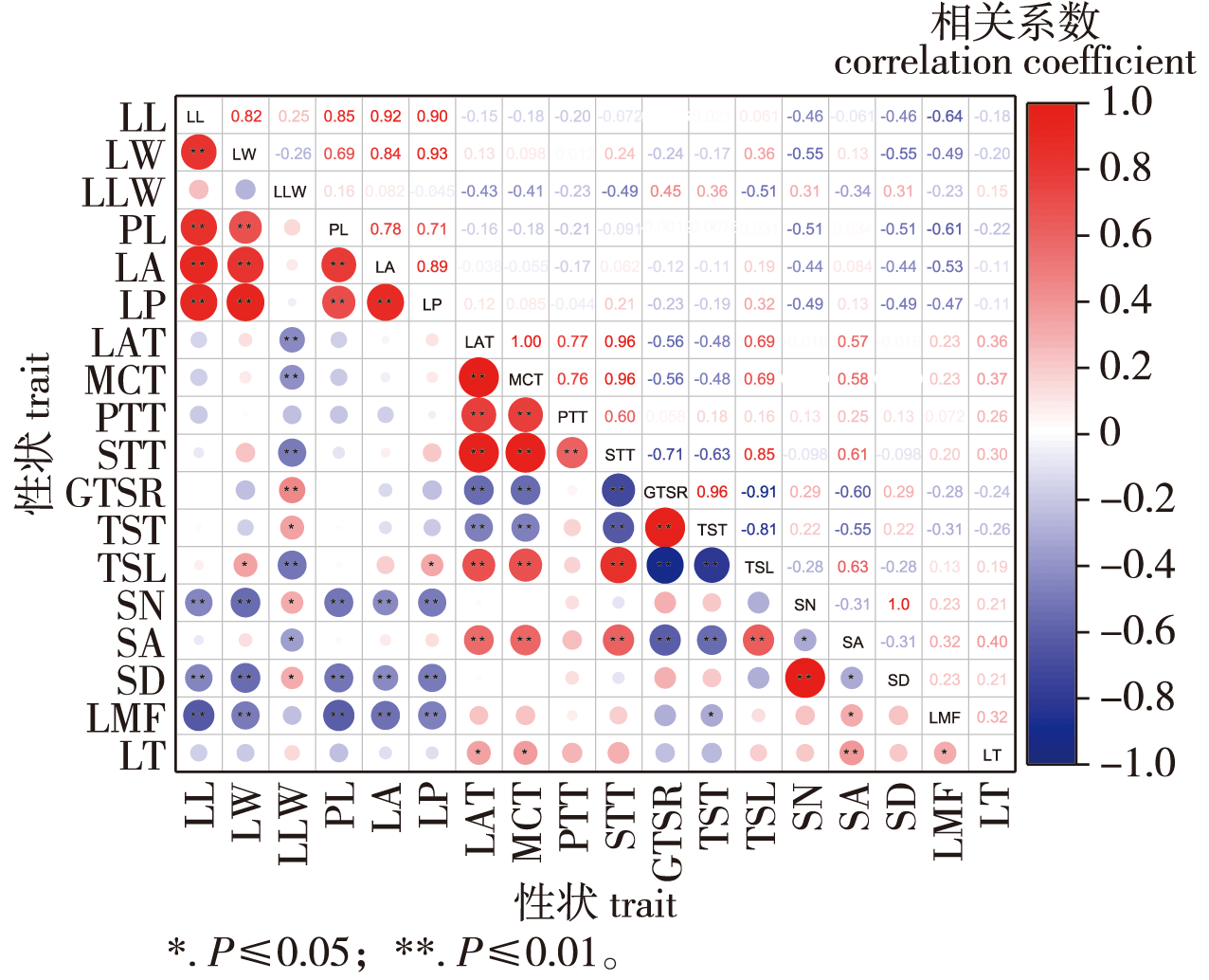 PDF(1949 KB)
PDF(1949 KB)


 PDF(1949 KB)
PDF(1949 KB)
 PDF(1949 KB)
PDF(1949 KB)
冬青种质资源叶表型多样性分析
Leaf phenotypic diversity analysis of holly germplasm resources
【目的】了解冬青种质资源叶表型多样性,揭示冬青种质资源的表型多样性机理,为引种栽培与品种选育提供依据。【方法】对42份冬青种质资源的18个表型性状进行测定,通过差异分析、方差分析、主成分分析和聚类分析研究其表型变异。【结果】冬青种质资源叶表型性状变异较大,尤其是叶面积;Shannon多样性指数变化范围为1.00~2.03;冬青种质资源叶表型性状变异丰富,变异主要来源于种间。相关性分析发现,各性状之间存在显著相关,叶片外部性状与叶片解剖性状呈显著负相关;通过主成分分析提取了叶长、叶片紧实度、栅栏组织和气孔密度4个主成分,累计贡献率为85.20%,基本能反映冬青属植物的总体性状表现;聚类分析将42份冬青种质资源分为大叶-大叶柄类、小叶-小叶柄类、中叶-叶硬锯齿类和中叶-叶薄纸质类4大类群。【结论】冬青种质资源叶表型性状变异丰富,属内变异主要来源于物种间。叶片外部性状是冬青种质资源表型分化的主要因素;叶长、叶片紧实度、栅栏组织和气孔密度是划分冬青种质资源的4个主导因子,可作为冬青种质资源的分类鉴定依据。本研究可为冬青属植物的分类、资源利用和栽培繁育提供理论参考。
【Objective】 This study aims to understand the leaf phenotypic diversity of holly (Ilex spp.) germplasm resources, elucidate the mechanisms behind this diversity, and support the introduction, cultivation and breeding of new varieties. 【Method】 We observed 18 phenotypic traits across 42 holly germplasm resources and analyzed the phenotypic variation using differential analysis, variance analysis, principal component analysis (PCA), and cluster analysis. 【Result】 There was significant variation in the leaf phenotypic traits among the holly germplasm resources, particularly in leaf area. The Shannon diversity index ranged from 1.00 to 2.03, indicating rich phenotypic diversity primarily due to interspecies variation. Correlation analysis showed a significant negative relationship between external leaf traits and anatomical traits. PCA identified four principal components, namely leaf length, tissue compactness, palisade tissue thickness, and stomatal density, that accounted for 85.20% of the variation, effectively capturing the overall characteristics of the holly plants. Cluster analysis grouped the 42 resources into four categories based on their leaf traits: large leaf with large petiole, small leaf with small petiole, medium leaf with hard serrations, and medium leaf with thin texture. 【Conclusion】 The study confirms substantial intrageneric phenotypic diversity in holly, driven predominantly by interspecies differences. External leaf traits were pivotal in phenotypic differentiation. The identified principal components, namely leaf length, compactness, palisade structure, and stomatal density, are crucial for classifying and identifying holly germplasm resources. Based on the leaf phenotypes, the resources were categorized into four distinct groups, providing a theoretical foundation for further classification, resource utilization, and breeding within the genus Ilex L.

Ilex(holly) / leaf phenotypic / traits variation / cluster analysis
| [1] |
李伟, 王攀, 其其格, 等. 蓝莓种质资源表型多样性研究[J]. 北京林业大学学报, 2020, 42(2):124-134.
|
| [2] |
|
| [3] |
|
| [4] |
|
| [5] |
周鹏, 祝亚云, 刘博, 等. 中国冬青属物种多样性空间格局[J]. 中南林业科技大学学报, 2022, 42(5):126-132.
|
| [6] |
|
| [7] |
张婷, 焦连庆, 刘融融, 等. 苦丁茶冬青多酚类化合物抗氧化活性谱效关系研究[J]. 中国药学杂志, 2023, 58(6):489-496.
|
| [8] |
|
| [9] |
廖坤莹, 李荣, 张天奉, 等. 毛冬青治疗心力衰竭的药理学研究进展[J]. 广州中医药大学学报, 2022, 39(8):1947-1952.
|
| [10] |
|
| [11] |
潘学峰, 邵国伟, 刘国民. 苦丁茶冬青不同种质材料的花果形态学观察[J]. 热带生物学报, 2018, 9(3):350-357.
|
| [12] |
覃冬梅. 6种金花茶叶片表型和SCoT遗传多样性研究[D]. 南宁: 广西大学, 2020.
|
| [13] |
王心可, 郭庆梅. 冰冻切片技术在高等植物中的应用[J]. 植物生理学报, 2021, 57(5):1047-1054.
|
| [14] |
方纯娇, 韩雪, 史冬燕, 等. 牡丹叶片气孔观察方法的比较研究[J]. 安徽农业科学, 2016, 44(13):41-42,76.
|
| [15] |
叶春秀, 庄振刚, 李有忠, 等. 棉花叶片气孔制片方法比较及改良[J]. 分子植物育种, 2014, 12(3):543-546.
|
| [16] |
王永康, 吴国良, 赵爱玲, 等. 枣种质资源的表型遗传多样性[J]. 林业科学, 2014, 50(10):33-41.
|
| [17] |
刘博文, 黎桂阳, 常媛飞, 等. 野豌豆属种子形态多样性与种子分类鉴定方法的研究[J]. 草地学报, 2021, 29(7):1375-1385.
|
| [18] |
葛颂, 王明庥, 陈岳武. 用同工酶研究马尾松群体的遗传结构[J]. 林业科学, 1988, 24(4):399-409.
|
| [19] |
张捷, 李蓉蓉, 孟景祥, 等. 我国风铃木类植物叶性状表型变异与遗传多样性研究[J]. 植物研究, 2021, 41(6):851-861.
|
| [20] |
姚程程, 王俊臣, 胡继文, 等. 香椿种质生长及叶部表型性状的遗传变异分析[J]. 植物科学学报, 2020, 38(1):112-122.
|
| [21] |
戴小红, 孙伟生, 贺军军, 等. 我国野牡丹属植物的表型多样性研究[J]. 热带作物学报, 2014, 35(10):2036-2042.
|
| [22] |
|
| [23] |
李相传, 孙柏年, 林志成, 等. 冬青属植物的叶表皮特征及其分类学意义[J]. 兰州大学学报(自然科学版), 2010, 46(4):13-21,29.
|
| [24] |
伊六喜, 高凤云, 周宇, 等. 胡麻种质资源表型性状的鉴定与分析[J]. 中国油料作物学报, 2020, 42(3):411-419.
|
| [25] |
|
| [26] |
|
| [27] |
周喜军, 张冬梅, 罗玉兰, 等. 冬青属植物的ISSR标记分析及其应用[J]. 河南农业大学学报, 2009, 43(2):196-200,209.
|
| [28] |
章建红, 高云振, 张斌, 等. 26种冬青属植物遗传多样性分析[J]. 西北植物学报, 2011, 31(3):504-510.
|
/
| 〈 |
|
〉 |